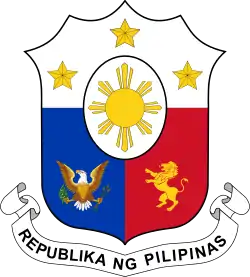1984 Philippine parliamentary election
A parliamentary election were held on May 14, 1984 in the Philippines. Like past elections, charges of bribery, protests and complaints on irregularities marred the elections. Former Manila Times publisher Chino Roces and former senator and opposition leader Jose W. Diokno supported the campaign boycotting the election. The National Movement for Free Elections (NAMFREL) helped mitigate electoral fraud during the election.
| ||||||||||||||||||||||
197 (of the 200) seats in the Regular Batasang Pambansa 101 seats needed for a majority | ||||||||||||||||||||||
|---|---|---|---|---|---|---|---|---|---|---|---|---|---|---|---|---|---|---|---|---|---|---|
| ||||||||||||||||||||||
| ||||||||||||||||||||||
 |
|---|
| This article is part of a series on the politics and government of the Philippines |
|
|
Although the Kilusang Bagong Lipunan retained a majority in parliament, the United Nationalist Democratic Organization scored a strong victory, winning 60 seats and reducing the ruling party's majority to 114 compared to the 150 they had in 1978. This was the first Philippine election to happen after the end of the controversial martial law period from 1972 to 1981.
The opposition's success was due in most part because of the public fallout after the assassination of Benigno Aquino Jr. on August 21, 1983 following a return from self-imposed exile from 1980. His death exposed an increasingly incapable administration under Ferdinand Marcos, exposing serious corruption and nepotism within, including from Marcos' wife Imelda Marcos, as well as exposing Marcos' worsening health at that time. As a result of Aquino's assassination and subsequent investigation, opposition became more widespread and united, rallying under his wife Corazon Aquino. The economy was also in crisis with severe poverty and debt dragging down growth, which was attributed to the Reagan administration's decision to distance itself from Marcos following Aqunios death, resulting in fewer investments that boosted the regime earlier before.
The gains from the United Nationalist Democratic Organization, among other factors would force Ferdinand Marcos to call the emergency 1986 snap election, which would ultimately see him ousted following accusations of fraud, leading to Corazon Aquino's becoming president.
Events leading to the Regular Batasang Pambansa elections
After the assassination of opposition leader former Senator Benigno Aquino, Jr. in 1983, the opposition ran for the Regular Batasang Pambansa under the United Nationalist Democratic Organization (UNIDO) and the Partido Demokratiko Pilipino-Lakas ng Bayan (PDP–Laban) against the ruling Kilusang Bagong Lipunan of Ferdinand Marcos.
Results
| District | Other | ||||||||||
|
|
| Party | Votes | % | Seats | +/– | |
|---|---|---|---|---|---|
| Kilusang Bagong Lipunan | 110 | −40 | |||
| United Nationalist Democratic Organization | 35 | +35 | |||
| Coalitions | 17 | +17 | |||
| Partido Demokratiko Pilipino-Lakas ng Bayan | 6 | +6 | |||
| Independent KBL | 4 | +4 | |||
| Nacionalista Party | 2 | 0 | |||
| Mindanao Alliance | 1 | 0 | |||
| Concerned Citizens' Aggrupation | 1 | +1 | |||
| Partido Panaghiusa | 1 | +1 | |||
| Independent | 6 | +5 | |||
| Sectoral seats | 14 | 0 | |||
| Appointed seats | 3 | 0 | |||
| Total | 200 | +10 | |||
| Source: Julio Teehankee. "Electoral Politics in the Philippines" (PDF). quezon.ph. | |||||
